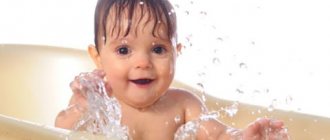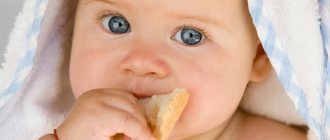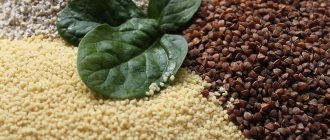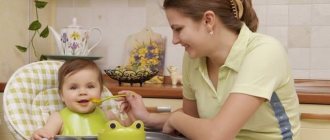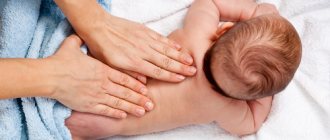Hello, dear friends! Today we will talk about how to harden a baby. After all, hardening children under one year is a very important point that should not be overlooked. The body of a newborn baby really needs support. The child is just getting used to living in this world with a far from favorable environmental situation. There are billions of infections around, and if you don’t boost your child’s immunity from birth, he simply won’t be able to resist them. How to harden a baby correctly? What should you pay special attention to?
Why hardening is needed
Hardening trains the immune system. In other words, this is a set of procedures aimed at preparing the body for dramatically changing environmental conditions. What exactly: strong wind, draft, frost, rain. When hardening, the resistance of immunity to microorganisms increases: bacteria and viruses.
Hardened children get sick less often and tolerate diseases much easier.
At what age should you start tempering your child?
They begin to harden the baby from the first days of birth. By washing, bathing, and dressing the baby, parents do not even suspect that they are thereby training his thermoregulation.
It must be said that a child is born already prepared for external natural conditions. But overly caring mothers and grandmothers violate this natural ability by overly wrapping them in clothes and taking care of them.
The sooner you start, the better. But this does not mean that if a child is three to five years old, then it is too late to toughen up. You can start at any age. By following the principles and rules of hardening, you will achieve the same results as if you had been practicing since birth.
Water hardening methods: basic methods
Special forms of water hardening should begin with local procedures and then move on to general ones.
In order of increasing strength of impact, water hardening methods are distributed as follows:
- Rubdowns
- Pouring
- Baths
- Shower
- Swimming in open water
The initial water temperature should be close to the skin temperature of those parts of the body that will be exposed to it.
Table “Skin temperature of children of different ages in the thermal comfort zone”:
| Body parts | Skin temperature (degrees) | |
| in children 3-4 years old | in children 5-6 years old | |
| Breast | 35-36 | 34-35 |
| Brushes | 32-34 | 31-33 |
| Feet | 30-33 | 28-31 |
The hardening effect of water is determined not only by temperature, but also by the duration of action, as well as by the force of pressure of the water mass.
The most favorable time to start water hardening is summer and autumn. It is best to carry out procedures in the morning, immediately after sleep or at the end of morning exercises.
When starting water hardening, first take light water procedures with a water temperature of 33-34 ° C. Then, every 3-4 days, reduce the water temperature by 1 °C and gradually, over 1.5-2 months, bring it up to 10-15 °C, depending on your well-being and state of health.
In the heat of July, temperatures can be even lower. The colder the water, the shorter the procedure time should be.
When hardening with water, the following types of procedures are recommended: rubbing, dousing, showers, bathing.
Principles of hardening
Often, the determining factor whether to harden a child or not is the psychological unpreparedness of the parents. Remove all fears and doubts. And forward to a healthy lifestyle!
- Good mood. It is important! Hardening will be beneficial if the baby is positive. The best way to achieve this is to play with it.
- Regularity. Procedures must be carried out constantly. Breaks lead to a weakening of adaptation mechanisms. In babies under one year of age, skipping 5-7 days leads to the disappearance of the effect.
- Gradualism. The dosage should be increased gradually. A sudden change puts the body into a state of shock and stress.
- Individual approach. If the child is sick or after sick leave, you need to wait with hardening. Children with weak immunity are strengthened according to an individual, gentle schedule.
- Taking into account age characteristics. Each age has a limitation on the duration of hardening procedures and a range of permissible temperatures. Do not overdo it!
Air hardening
The most affordable way. Used from birth. And the first thing you need to start with is to stop wrapping the baby.
We remove the excess vest. Additional clothing causes the child's adaptive mechanisms to weaken. His body gets used to “greenhouse conditions”, and the slightest drop in temperature leads to hypothermia.
Regular ventilation. Conducted from the moment of birth. In summer, the windows should be open all the time. Drafts are not allowed. The optimal temperature in the baby’s room is +20–+22°C.
In the cold season, rooms are ventilated for 15 minutes 5-6 times a day. They do this in the absence of the child. The best effect is provided by through ventilation.
Air baths. Conducted from the first days of birth. When changing clothes, the newborn baby is left naked for 2-3 minutes. Once every two weeks, increase the time by 1-2 minutes. By six months, 10 minutes is acceptable. After six months, the time is increased to 15 minutes. Air baths are done 2-3 times a day at room temperature.
There are warm (+20°C), cool (+17—+ 19°C) and cold (+15°C) baths.
- 0-3 years use warm,
- 3-4 years they make cool ones,
- For 5-6 years, cold baths are allowed.
This procedure is carried out in combination with physical activity. For newborn babies, the mother gives exercises or massage. With older children, it is advisable to play (for example, throw a ball), do simple exercises, or give them the opportunity to move (jump, run).
Walks. If the weather is good, they go for a walk after being discharged from the hospital. In summer from 20 minutes or more. It is better to choose places for walking away from the roadway. If possible, walk in nature: in the forest, in a clearing, in the shade of an alley.
In autumn, winter, cold spring, in calm weather, people begin to walk for 15 minutes, gradually increasing the time to 1-1.5 hours. Infants are allowed to walk at least -10°C.
A preschool child needs to be outside as often as possible in the summer. In winter it is permissible to walk down to -15°C, duration 1-2 hours.
Both infants and preschoolers should be outside twice a day: in the first half of the day and after lunch.
Walking in adverse conditions. Walking in any weather gives a good hardening effect. They begin after 1.5-2 years. The child is taken out into cloudy, windy weather for 3-5 minutes. At the same time, the baby must move actively so as not to freeze. Don't wear extra blouses.
It is allowed to walk with a preschooler (3-6 years old) in light rain, snowfall, and wind. The main rule is to gradually increase the stay time to 15-20 minutes, and monitor the child’s condition (so that he does not overheat or become hypothermic).
We also read: Hardening children under one year old with air (air baths)
Water hardening
Children especially enjoy water treatments. In addition to being good for the immune system, water also has a calming effect.
Washing. They do it from birth. Initially, the water temperature is +28°C. Gradually (every 2-3 weeks) it is lowered by 1-2°C, by six months it is brought to +25°C, by a year to +20°C.
Washing is carried out daily in the morning, before bed and as needed. First the baby's face is wiped, then his hands.
For preschool children, the water temperature is reduced:
- 3-4 years - up to +18°С
- 5-6 years - up to +16°C
Rubbing. Starts at 6 months. To do this, take a soft mitten (or towel) and moisten it in water at +35°C. They wipe the child in the following order: arms, legs, back, chest and tummy. Afterwards, wipe dry. Every 2 weeks the temperature is lowered by 1-2 degrees and brought to +28°C.
Pouring:
- General dousing. They do it from birth. Each time after bathing, the baby is raised above the bath with his back up and water is poured over him for several seconds. The main rule is that the water temperature should be a couple of degrees lower than in the bath.
- Local dousing. Recommended from 2 years of age. The baby's feet are watered for 20-30 seconds. Initially, the water temperature is +30°C. Once every 2 weeks it is reduced by a couple of degrees. At 4 years of age, the temperature is allowed to be +18°C; by 5-6 years of age it is brought to + 16°C.
Cool shower. After 3 years, general dousing is replaced with a shower. Starting from a temperature of +35-+36°C, the water is gradually reduced to +26°C. Duration - a few seconds. After the procedure, the child is wiped dry and dressed.
Swimming in open waters. Acceptable from an early age. In summer, children can be bathed in rivers, lakes, and the sea at a water temperature not lower than +22°C. Start with 1-2 minutes, gradually increasing to 5-8.
Children 3-5 years old are allowed to swim at a water temperature of +19-+20°C, and the time is increased to 10 minutes.
Sun hardening
Magic sun:
- Prevents rickets.
- Has an antimicrobial effect.
- Increases the resistance of the immune system to colds.
And gives a good mood!
Walking in the sun. In summer weather, infants begin to walk for 2 minutes under the scattered rays of the sun. Gradually (every 3-4 days) parents increase the time by 1-2 minutes and bring it up to 10-15.
Sunbathing. It is not recommended to spend up to a year. The baby is stripped down to his panties and allowed to play in the sun.
Age/time:
- 1-3 years - 5-10 min.
- 3-7 years - 10-15 min.
It is advisable to carry out such procedures near a water source. Sunbathing in combination with dousing gives a good hardening effect. First, the baby basks in the sun, then he is sprayed with water.
Hardening is carried out in the first half of the day before 11.00, and in the second half after 16.00. When the sun is not at its peak to avoid burns. The child must wear a hat.
In heat above +30°C, hardening procedures are not carried out.
Read also: How to harden children under one year old in the sun - rules
Video: 8 points about hardening a child
Other hardening methods
They harden both the entire body and its individual parts: feet, throat. You can use household items, such as a fan.
- Hardening with a draft (or fan). Starts after 3 years. The procedure is carried out at an air temperature of +20–+22°C. The child is placed at a distance of 6 meters from the fan in light clothing. The speed of the blades is minimal. They start with 20 seconds, while the baby must toss and turn so that the air blows from all sides. Gradually (once every 2 weeks) increase the time and speed of fan rotation;
- Gargling with cold water. From 3 years old. Initially, the water temperature is set at +25°C. Every four days it is reduced by 1°C and brought to 8°C. The child should take water into his mouth and pronounce the sound A-A-A for a long time. Then spit it out. The procedure is repeated several times;
- Walking barefoot. They have been practicing since the child began to walk. When the floor surface temperature is +18°C, the baby walks in socks. After a week, the socks are removed and he runs barefoot for 3-7 minutes. In summer it is useful to walk on sand, grass, and pebbles.
Ice hardening
- Resorption. A small cube of frozen decoction of calendula or chamomile is placed in the child’s mouth and offered to be sucked on like a lollipop. After 30 seconds, remove. The time is increased by 10 seconds every 4 days and brought to 2 minutes. It can be frozen berries, syrup;
- Wiping your heels. Acceptable from three years. For a few seconds before going to bed, rub the child's feet with pieces of ice. After this, wipe dry and put on socks. The procedure is carried out 2 times a day.
Intensive and contrast hardening
All of the above methods refer to moderate hardening. Which is based on the principle of gradualism. But there are also more extreme ways. For example, intensive and contrast hardening. These methods are based on a sharp change in temperature over a wide range for a short period of time.
Intensive hardening. The essence of this method is short-term contact of the body with frost, snow, and ice water.
This includes:
- Pouring water at extremely low temperatures;
- Wiping with snow;
- Dipping into an ice hole in winter.
These are quite extreme methods of hardening. They are not recommended for preschool children. Although some active parents practice it quite successfully even with infants.
Contrast hardening. A more gentle procedure. It is based on alternating, sharp changes in temperature with a large difference.
For example:
- Dipping your feet in either warm or cold water;
- Cold and hot shower.
Why hardening with cold water is useful: basic principles
The physiological effect and benefits for the human body of hardening with cold water are as follows:
- The regulatory function of the central nervous system improves
- Metabolism increases
- The protective function of the blood increases
- Hemoglobin content increases
- The physical and neuropsychic development of the child is improved
- Develops the ability to quickly adapt to changing conditions and resist harmful environmental factors
Water acts much more strongly than air, which is explained by its greater heat capacity and thermal conductivity.
There are three phases of the effect of cold water on the body:
- A sharp spasm of blood vessels - blood flows to the internal organs, the skin becomes pale and cold, the first chill occurs
- Dilation of the blood vessels of the skin, a rush of blood from the internal organs to the periphery, a feeling of warmth
- Paretic state of dilated capillaries, blood stagnation, the appearance of cyanosis, the occurrence of a second chill
The healing effect of hardening the body with cold water at home is due to the first and second phases. The onset of the third phase reflects decompensation of physical thermoregulation; The child should be dried immediately with a light massage until the skin turns pink.
When hardening with water, just as with other types of hardening, one must strictly observe the principle of a gradual transition from warmer to cooler water. When choosing the initial and extremely low temperatures, it is necessary to take into account the individual characteristics of the child’s body.
A gradual increase in the irritating effect of water can be achieved in various ways and their combination: replacing weak procedures with strong ones, replacing local ones with general ones, lowering the water temperature.
All hygienic measures using water can simultaneously be hardening procedures. Hardening with water will be ineffective if special techniques are performed with cool water, and ordinary washing with warm water.
Basic principles for the correct use of cool and cold water for hardening purposes:
- All hygienic procedures associated with the use of water can have a hardening effect if the appropriate rules are followed.
- As a local action of water you can use: washing, wiping, washing hands, washing and pouring feet, playing with water, rinsing the mouth and throat
- As a general effect of water, you can use: a hygienic bath followed by dousing with colder water, general wiping, dousing, showering and swimming in open water.
- When choosing hardening effects, one must take into account the child’s condition and the characteristics of his higher nervous system.
Contraindications
Signs and diseases for which hardening measures are not carried out:
- Negative attitude of the child towards procedures;
- Malaise, temperature above normal;
- Signs of a cold;
- Intestinal diseases;
- Increased excitability (hyperactivity);
- Acquired (decompensated) heart disease;
- Exhaustion of the body;
- Reduced hemoglobin;
- Diseases of the epidermis (skin);
- Respiratory system disorders.
Every parent worries about their own child, but sometimes these fears do more harm than good. To prevent a cold, do not wear extra blouses and pants, but train your immune system. In other words, get ready for your health!
Read also: How to start hardening a newborn baby. Rules and methods of hardening
Rinse your mouth and throat
A pronounced healing effect is achieved by systematically rinsing the mouth and throat with water at room temperature.
“Bubbling” water has a massaging effect on the mucous membranes of the oral cavity, tonsils, and the back wall of the pharynx. Water washes away food debris and mucus (which prevents the proliferation of microbes), improves the reaction of the local vascular network and has a hardening effect.
At the age of 2-3 years, you can teach a child to rinse his mouth, and then, having filled his mouth with water, throw his head back and pronounce the sound “a-a-a”. At 4-5 years old, it is imperative to gargle (each gargle takes about 1/3 cup of water).
Repeated twice a day (morning and evening), this simple procedure prevents the development of dental caries and sore throat. The hardening effect is achieved if the initial water temperature of 36-37 °C is gradually reduced every 3-4 days by 1 °C and brought to 8-10 °C.
Seasoned children can be gradually switched to ice cream (in small portions). It is advisable to teach children who do not know how to gargle to drink cool water, also gradually reducing the temperature.
It should be noted that during a general douche and shower, water acts on the skin receptors not only with its temperature, heat capacity and thermal conductivity, but also with the pressure of the falling mass. (During general dousing, a vessel with water is brought close to the child’s neck, water is poured onto the shoulders, chest and back.)
Dousing the head is allowed only from a watering can with a net and mainly in the summer. When using a shower, the sprayer is raised 40-45 cm above the child’s head, and the head is first covered with a bathing cap.
The greater effect of the shower is due to the pressure of individual thin streams of water. The duration of the general douche and shower used for the purpose of hardening should not exceed 1-1.5 minutes. If the shower is used for hygienic purposes, then the child is washed with warm water (36 ° C) in the same way as with a general bath.
How to harden a child's throat
We said above that hardening is a versatile phenomenon. In particular, it can be not only general, but also local. It is not necessary to arrange a bath; you can only harden the throat separately. This method will protect the child's immunity if he ate cold ice cream or drank an ice-cold drink.
View this post on Instagram
Publication from Business for Housewives with Batel (@natalie.on_line)
You need to start gargling with water at a temperature of about 25 degrees. Intensity: 2 times a day. With each new week the water should become cooler by 1-2 degrees. It is necessary to lower it to 8 degrees.
If your son or daughter does not want to gargle, and all arguments are powerless, then you can cheat a little. For example, encourage your child to eat a teaspoon of ice cream three times a day. He definitely won’t refuse this.
- How to gargle with a sore throat for an adult and a child: 9 recipes that definitely work
At the same time, specify that the treat will be given in the specified volume, provided that he holds it in his mouth for up to 10 counts and only then swallows it. After a week, you can give a whole teaspoon of ice cream. You can also harden your throat with frozen juice or a decoction of herbs, offering a delicious piece of ice instead of another candy.
Note to parents
It is important to know that any hardening activities cannot be started if the child has recently suffered a serious illness. All physiotherapy procedures should be in accordance with the season and start small. The procedure time gradually increases.
If the baby suffers from any chronic disease, then a doctor’s consultation is necessary in order to know which hardening measures are indicated and which are contraindicated for your child.
Showering as a means of hardening with water
A shower as a means of hardening can be used when the child is already one and a half years old, but the doctor may prescribe it earlier for any indication (a shower is often prescribed for lethargic children, especially those with poor appetite).
Showering is an even more effective water treatment. At the beginning of hardening, the water in the shower should be 30-35 ° C, and the duration of the procedure should not be more than 1 minute. Then the water temperature gradually decreases to 16-14°C, and the shower time increases to 2 minutes. The water from the shower feels warmer than water of the same temperature when doused or rubbed.
The procedure ends with vigorous rubbing of the body with a towel. As a rule, after taking a shower, a cheerful and good mood appears, and productivity increases.
For preschool children who are systematically hardened with air and water, a combined effect is advisable: air bath - dousing.
Even after thorough drying, the skin remains extremely moist, and to prevent excess heat loss, it is protected with clothing. Properly carried out combined hardening contributes to a more perfect adaptation of thermoregulation processes to changing environmental factors.
Attention! Water procedures must be carried out daily 1-2 times a day and be sure to follow the following rules: if the child is sweating, then before hardening he should take a shower with warm water and wash off the sweat with soap, but if he is frozen, then dousing him with cold water cannot be done.
You can only douse yourself with cold water when you are comfortable. After dousing, the child does not experience cold; on the contrary, when the procedure is performed correctly, a feeling of spreading pleasant warmth arises.
